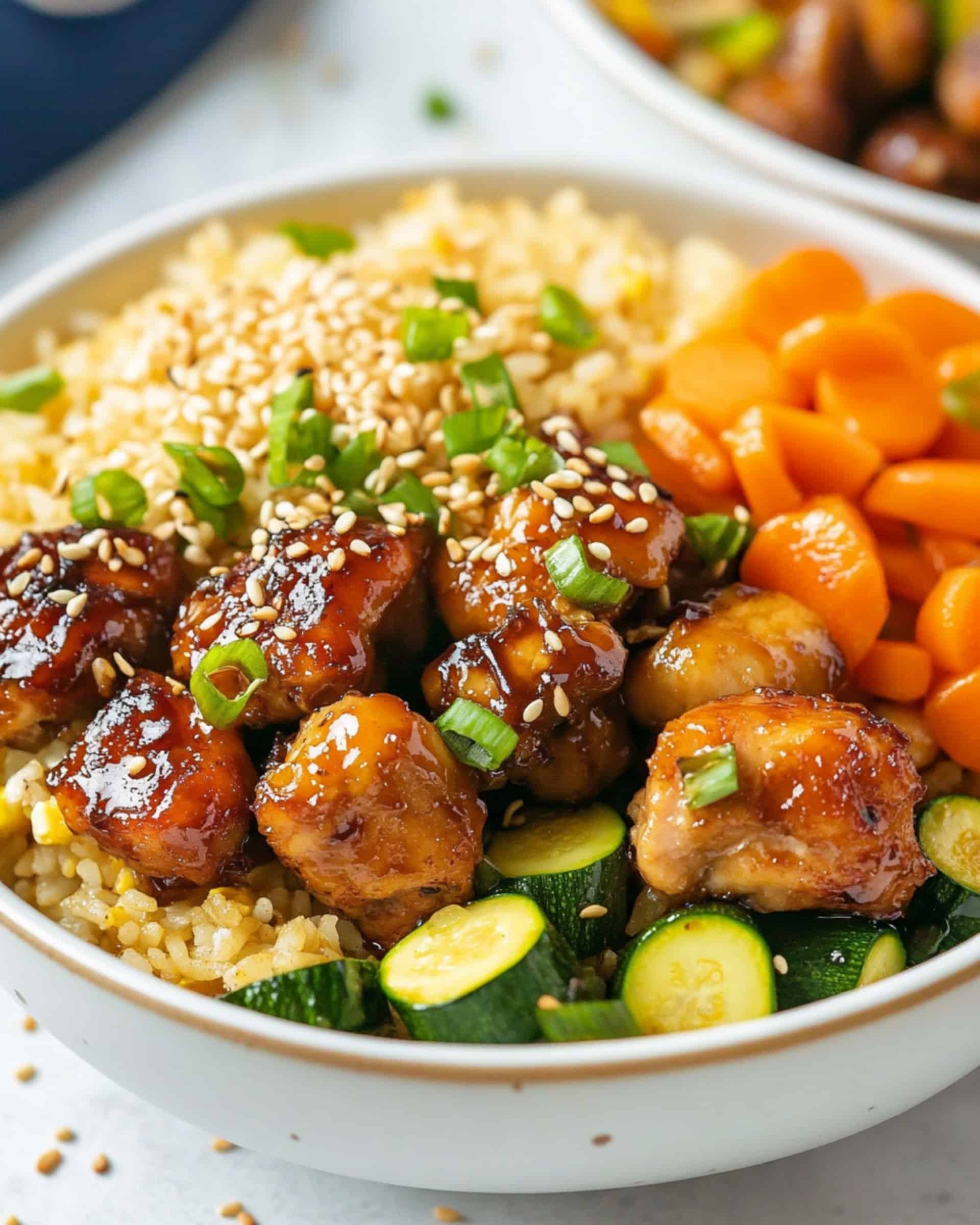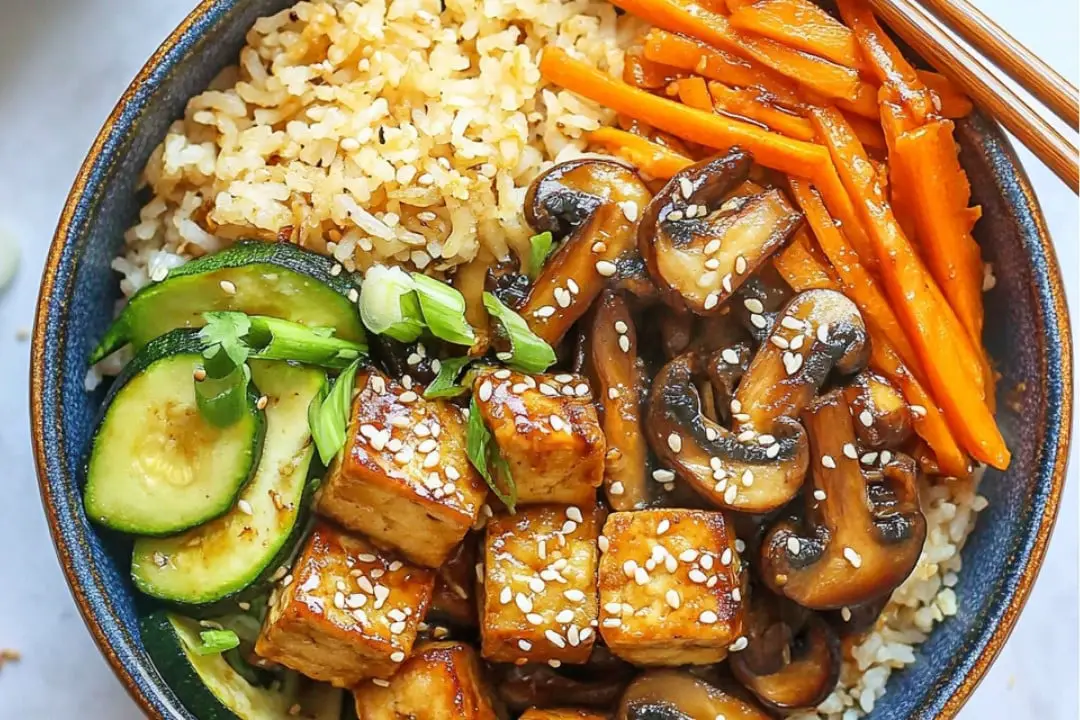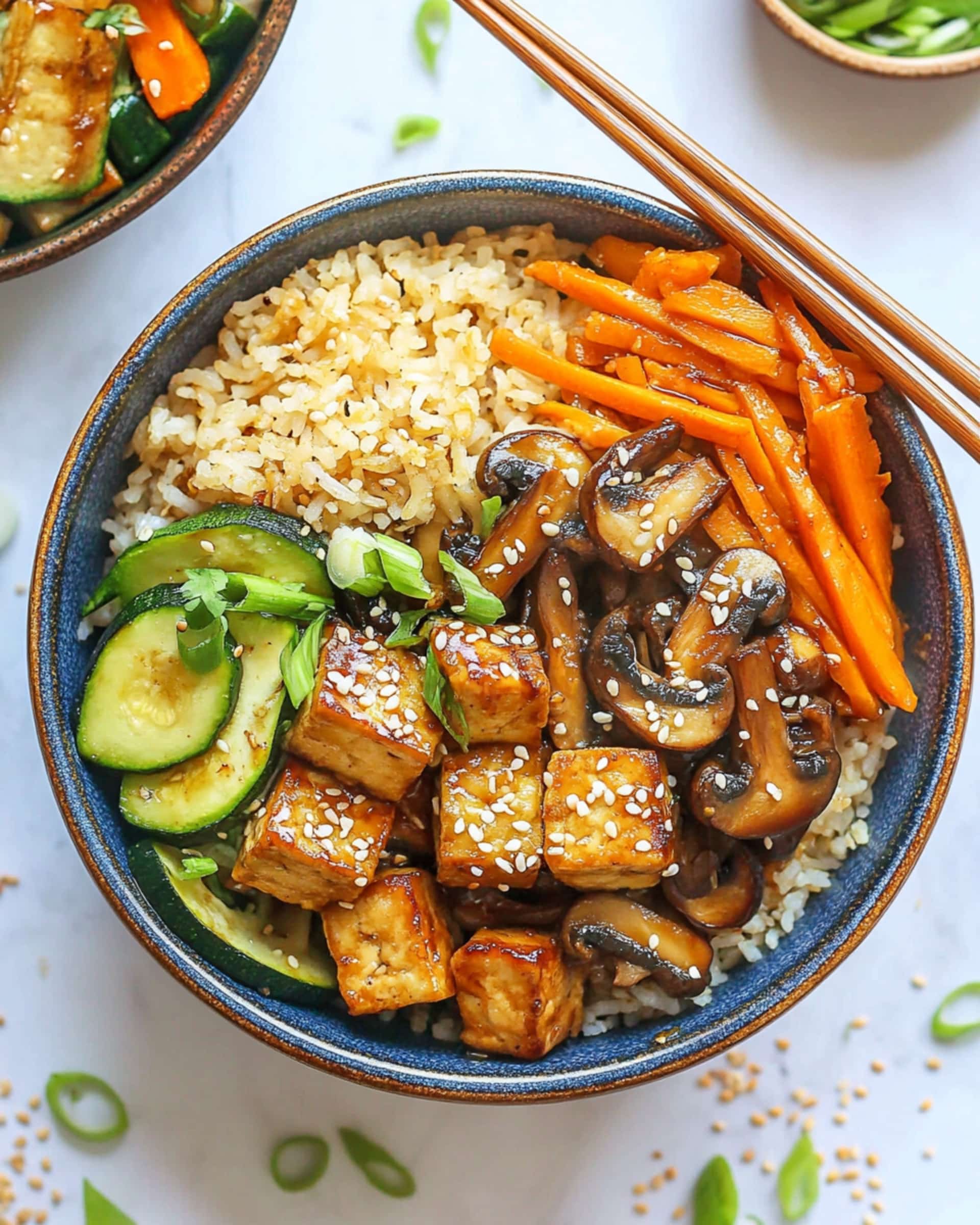This mouthwatering Homemade Hibachi Style Chicken Bowl brings the exciting flavors of a Japanese steakhouse right to your kitchen! Tender marinated chicken, perfectly sautéed vegetables, and a flavorful rice blend come together for a restaurant-quality meal that’s surprisingly simple to make at home. Ready in about 30 minutes of active cooking time, these satisfying bowls are perfect for meal prep or a fun family dinner that everyone will love.
Why You’ll Love This Recipe
- Restaurant Experience at Home: Capture all those delicious flavors you crave from hibachi restaurants without the hefty price tag or having to leave your house.
- Customizable: The beauty of these bowls is how easily you can adapt them to your taste preferences and what you have on hand – switch up the proteins, vegetables, or make it as mild or spicy as you like.
- Meal Prep Champion: These bowls hold up beautifully for several days in the refrigerator, making them perfect for busy weeknight planning or lunch meal prep.
- Healthier Alternative: By controlling exactly what goes into your bowl, you’re getting all the flavor of takeout with significantly less oil, sodium, and no questionable additives.
Ingredients You’ll Need
- Chicken breast: The star protein that becomes incredibly flavorful thanks to the marinade. Cut it into bite-sized pieces to ensure quick, even cooking and maximum flavor absorption.
- Coconut aminos: The secret weapon in this recipe! Provides a soy sauce-like flavor with less sodium and a hint of sweetness. It appears in multiple components of this dish because it’s that essential to the flavor profile.
- Sesame oil: Adds that distinctive nutty flavor that’s characteristic of Asian cooking. A little goes a long way here!
- Garlic: Brings aromatic depth and savory notes that permeate the entire dish. Fresh is definitely best for this recipe.
- Hoisin sauce: This thick, fragrant sauce adds complexity with its sweet and savory balance. Think of it as Chinese barbecue sauce that gives the chicken a beautiful glaze.
- Ginger paste: Provides that signature warm, spicy kick that’s essential in hibachi cooking. Fresh grated ginger works beautifully too if you have it.
- Zucchini, mushrooms, and carrots: This vegetable trio provides contrasting textures and colors. The zucchini stays slightly crisp, mushrooms add umami, and carrots provide sweetness and color.
- Jasmine rice and cauliflower rice: The combination gives you the perfect texture while boosting nutritional value. The cauliflower rice blends in beautifully once cooked.
- Eggs: Creates that authentic hibachi fried rice experience by adding protein and binding everything together with a silky richness.
- Green onions: Add both color and a fresh, mild onion flavor that brightens the entire dish.
- Dijon mustard: A surprising ingredient that adds tanginess and depth to the rice mixture without overwhelming the other flavors.
Variations
Protein Swaps
Substitute the chicken with thinly sliced steak for a hibachi steak bowl. Cut against the grain and cook for less time than the chicken. Alternatively, try shrimp (which cooks even faster) or tofu (press it well before marinating) for a vegetarian option.
Vegetable Options
The beauty of hibachi cooking is its flexibility. Try adding thinly sliced bell peppers, snap peas, broccoli florets, or baby bok choy. Just adjust cooking times accordingly—harder vegetables should go in the pan first.
Sauce Adjustments
If you don’t have coconut aminos, substitute with low-sodium soy sauce or tamari (use slightly less as they’re saltier). For a spicier kick, add sriracha to the marinade or a teaspoon of chili garlic sauce.
Rice Alternatives
For a lower-carb option, use all cauliflower rice. For a more traditional approach, go with all jasmine rice. Brown rice works well too, though you’ll need to adjust cooking time according to package instructions.
How to Make Homemade Hibachi Style Chicken Bowls
Step 1: Marinate the Chicken
In a sealable container, combine coconut aminos, sesame oil, minced garlic, hoisin sauce, ginger paste, salt, and pepper. Add your chicken pieces and mix thoroughly to coat. Cover and refrigerate for at least one hour, though overnight marination will produce the most flavorful results. Occasionally shake or stir to ensure even flavor distribution.
Step 2: Cook the Vegetables
Heat olive oil in a large wok or skillet over medium heat. Add your zucchini, mushrooms, and carrots, then drizzle with coconut aminos and season with salt and pepper. Sauté for 5-10 minutes until vegetables are tender-crisp – you want them cooked through but still vibrant and not mushy. Remove from the pan and set aside.
Step 3: Cook the Chicken
In the same pan, add a bit more olive oil and then add your marinated chicken along with any remaining marinade. Sauté for 7-10 minutes until the chicken pieces are golden brown and fully cooked (165°F internal temperature). The sauce should thicken slightly and coat the chicken beautifully. Transfer to a plate.
Step 4: Prepare the Rice Mixture
While the vegetables and chicken are cooking, prepare your jasmine rice according to package directions. Cook the cauliflower rice separately. Once the chicken is done, use the same pan to combine both rices. Push the rice mixture to the sides of the pan, creating a well in the center. Add a bit of oil or cooking spray in this space, then pour in lightly beaten eggs. Scramble the eggs, then incorporate them throughout the rice. Stir in coconut aminos, Dijon mustard, green onions, salt, and pepper until well combined.
Step 5: Assemble Your Bowls
Start with a base of the rice mixture, then arrange portions of vegetables and chicken alongside or on top. Garnish with toasted sesame seeds, additional green onions, red pepper flakes, or a drizzle of sriracha if desired.
Pro Tips for Making the Recipe
- Prep Ahead: Chop all vegetables and chicken in advance to streamline cooking. You can even marinate the chicken overnight for maximum flavor infusion.
- High Heat is Key: Use a hot pan for quick cooking that maintains vegetable texture and gives the chicken a nice sear while keeping it juicy inside.
- Don’t Overcrowd: Cook in batches if necessary, especially the vegetables. Overcrowding causes steaming rather than sautéing, which affects texture.
- Season Each Component: Don’t rely solely on the marinade for flavor. Season each element (vegetables, rice) separately to build layers of taste.
- Cast Iron or Wok: If you have either of these, use them! They distribute heat beautifully and give you that authentic hibachi-style sear.
How to Serve

Perfect Pairings
Serve these hibachi bowls with a side of clear onion soup or a simple miso soup for an authentic Japanese steakhouse experience. A small side salad with ginger dressing also complements the meal beautifully.
Sauce Options
Set out small bowls of spicy mustard, sriracha, additional coconut aminos, or yum yum sauce (Japanese steakhouse white sauce) for drizzling and dipping.
Family-Style Serving
For a fun dinner experience, place all components in separate serving dishes and let everyone build their own custom bowl. This works great for families with varying preferences.
Make Ahead and Storage
Storing Leftovers
Store components separately in airtight containers in the refrigerator for up to 4 days. The flavors actually continue to develop, making day 2 sometimes even more delicious than day 1!
Freezing
While the rice and chicken freeze well for up to 3 months, the vegetables tend to become waterlogged when frozen and thawed. If you do freeze, store in portion-sized containers for easy reheating.
Reheating
For best results, reheat in a skillet with a small splash of water or broth to revive the moisture. Microwave reheating works too – cover loosely and heat in 30-second intervals, stirring between each. Add a small drizzle of sesame oil after reheating to refresh the flavors.
FAQs
Can I make this recipe gluten-free?
Absolutely! Most of the ingredients are naturally gluten-free, but you’ll need to double-check your hoisin sauce and coconut aminos. Several brands offer gluten-free versions, or you can make a simple homemade hoisin with gluten-free ingredients. Also ensure any additional sauces for serving are certified gluten-free.
Why use both regular rice and cauliflower rice?
This brilliant combination gives you the familiar texture and satisfaction of traditional rice while adding nutrients and reducing the overall carbohydrate content. The cauliflower takes on the flavors beautifully while remaining nearly undetectable in the finished dish. It’s a great way to sneak in extra vegetables!
How can I make this dish more authentic?
For that true hibachi experience, cook each component separately on very high heat, using a flat-top griddle if you have one. Professional hibachi chefs also use a lot of butter, so you can substitute some of the cooking oil with butter for a more authentic flavor. Consider adding a dash of MSG (if you don’t avoid it) for that unmistakable restaurant taste.
Can I prepare the components ahead of time for a quick weeknight dinner?
This is one of the best make-ahead meals! Marinate the chicken and chop all vegetables up to 2 days in advance. You can even cook the rice ahead and refrigerate it (slightly undercook it if you plan to do this). When ready to eat, just sauté everything in sequence and you’ll have dinner on the table in about 15 minutes.
Final Thoughts
These Homemade Hibachi Style Chicken Bowls bring all the excitement and flavor of your favorite Japanese steakhouse right to your dinner table. With that perfect balance of tender marinated chicken, colorful vegetables, and flavorful rice, this recipe is bound to become a regular in your meal rotation. Even better, it’s endlessly customizable to suit your family’s tastes and what you have on hand. So grab your biggest skillet and get ready to impress – hibachi night at home awaits!
Print
Homemade Hibachi Style Chicken Bowls Recipe
- Prep Time: 10 minutes
- Cook Time: 20 minutes
- Total Time: 30 minutes
- Yield: 6 servings
- Category: Main-course
- Method: Stovetop
- Cuisine: Asian-inspired
- Diet: Diabetic
Description
A delicious homemade Hibachi-style chicken bowl recipe with marinated chicken, sautéed vegetables, and flavorful rice. Perfect for a quick yet flavorful main course dish.
Ingredients
Hibachi Chicken
- 2 lbs. boneless skinless chicken breasts, chopped into bite-sized pieces
- 1/4 cup coconut aminos
- 1 Tbsp. toasted sesame oil
- 4-5 cloves garlic, roughly minced
- 2 Tbsp. hoisin sauce
- 1 tsp. ginger paste
- Salt and black pepper, for cooking
- 1/2 Tbsp. olive oil, for cooking
For the Vegetables
- 1/2 Tbsp. olive oil
- 1 Tbsp. coconut aminos
- 2 medium zucchinis, chopped (3 cups)
- 8 oz. sliced crimini mushrooms
- 1 cup carrot chips (100g)
- Salt and black pepper
For the Rice
- 2 cups Jasmine Minute Rice, dry (192g)
- 2 cups water
- 10 oz. frozen riced cauliflower, cooked
- 2 Tbsp. coconut aminos
- 1 tsp. Dijon mustard
- 2 eggs, lightly scrambled
- 1/2 tsp. salt
- Black pepper, to taste
- 4 green onions, chopped
Optional Toppings
- Spicy mustard
- Toasted sesame seeds
- Red pepper flakes
- Chopped green onions
- Extra coconut aminos
Instructions
- Marinate the Chicken: Add the coconut aminos, sesame oil, garlic, hoisin sauce, ginger, salt, and pepper to a sealable bowl or bag for marinating. Mix together to evenly combine. Add the chopped chicken breast to the bowl and mix to coat. Cover and let marinate in the refrigerator for at least 1 hour, preferably overnight. Shake the bowl occasionally to evenly marinate the chicken.
- For the Veggies: Heat ½ Tbsp. olive oil in a large wok or skillet. Add the zucchini, mushrooms, and carrots to the pan and top with coconut aminos, salt, and pepper. Sauté over medium heat for 5-10 minutes until the vegetables are fork-tender. Remove the sautéed vegetables from the pan and set aside.
- Cook the Chicken: Add ½ Tbsp. olive oil to the same pan used for the vegetables. Add the marinated chicken and any remaining sauce. Sauté for 7-10 minutes until the chicken is browned, cooked through, and no longer pink. Ensure the internal temperature reaches 165°F with a meat thermometer.
- For the Rice: While the veggies and chicken cook, add the uncooked rice to a large microwave-safe bowl with 2 cups of water. Microwave for 8 minutes or per the package instructions. Cook the riced cauliflower according to its package instructions. When the chicken is done, remove it from the pan, set aside, and add the cooked rice and cauliflower rice to the same pan. Mix to combine and push the mixture to the edges of the pan, creating a hole in the center. Spray the center with nonstick spray and add the lightly scrambled eggs. Cook through, scramble in the pan, and mix with the rice. Add the coconut aminos, Dijon mustard, green onions, salt, and pepper. Mix to combine evenly.
- Assemble Your Bowls: Serve approximately 135 grams of rice (1 cup, loosely packed), 100 grams of vegetables (1/2 cup), and 130 grams of chicken (3/4 cup) per bowl. Top with toasted sesame seeds, red pepper flakes, sriracha sauce, or chopped green onions for serving.
Notes
- Nutritional information is an estimate and will vary with substitutions.
- If you do not want to assemble individual bowls, add the vegetables back to the chicken after the chicken has cooked through and serve over rice.
- You can use chicken, steak, or any preferred protein for this recipe.
- Swap in any vegetables you have on hand, whether leftover, fresh from the garden, or your personal favorites.
Nutrition
- Serving Size: 1 serving
- Calories: 346
- Sugar: 4g
- Sodium: 720mg
- Fat: 14g
- Saturated Fat: 3g
- Unsaturated Fat: 11g
- Trans Fat: 0g
- Carbohydrates: 28g
- Fiber: 3g
- Protein: 29g
- Cholesterol: 120mg




Your email address will not be published. Required fields are marked *